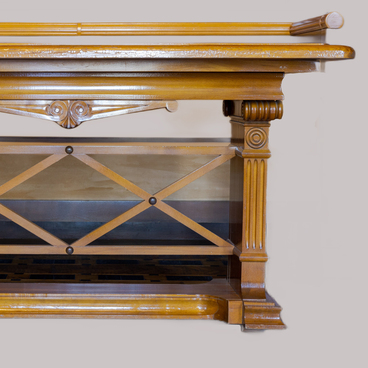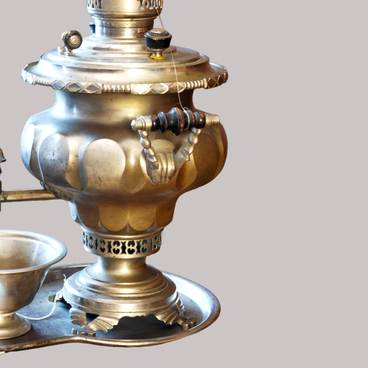The study desk is located in the study of Emperor Nicholas II in the Livadia Palace Museum.
The table is richly decorated with carvings and ornaments with the top mounted over two cabinets. There are drawers on the front of the apron (the connecting element of the desk’s top and the supporting parts). The top of the table is upholstered with green cloth and trimmed with a wooden belt with a carved floral ornament. Each cabinet is supported by four figures of lying lions. The lions are placed on a wooden stand — the same plane to which the table legs are attached. The stands are made in the form of flattened balls. The cabinets are rectangular, with decorative carved overlays at the joints. The outer and inner sides of these units are adorned with exquisite ornaments alluding to various subjects and themes and deserve a closer look. The cabinet on the left presents an outdoor composition with a group of human figures against the background of ships and two figures of men in military uniform with weapons.
Of great interest are the four carvings on the facades of the cabinets. They depict scenes from the life of Peter I. It is likely that these scenes were inspired by famous prints based on historic events from the times of his reign. In 1980, Karina Aristovna Orlova, senior researcher at the Department of Russian Culture of the State Hermitage Museum, performed an analysis of these carvings. According to her, the plot of the outer surface of the left cabinet refers to the “Founding of St. Petersburg” narrative.
The inner composition shows a man with a cup in his hand and a young man with a book. The right-hand cabinet depicts Peter I and five men sitting at a table. The outer part of the cabinet, on the side facing the person sitting at the desk shows Peter I sitting at a table with five men. It is suggested that this scene is connected to the disclosure of Tsykler’s conspiracy against Peter I. Tsykler was a supporter of Princess Sophia, sister of Peter I. The conspiracy was discovered in 1697 by people loyal to the Tsar.
The outer part of the right-hand cabinet, facing the visitors, shows a group of people in a room resembling a laboratory. On the inner surface is a group of people, in the center of the composition is a figure of a man with a child. According to experts and art historians, this fragment is based on a meeting between Tsar Peter I and French King Louis XV, who was still an infant during the reign of Regent Philip II of Orleans. The event happened in real life and took place in 1717 during a short visit of the Tsar to France.
The table is richly decorated with carvings and ornaments with the top mounted over two cabinets. There are drawers on the front of the apron (the connecting element of the desk’s top and the supporting parts). The top of the table is upholstered with green cloth and trimmed with a wooden belt with a carved floral ornament. Each cabinet is supported by four figures of lying lions. The lions are placed on a wooden stand — the same plane to which the table legs are attached. The stands are made in the form of flattened balls. The cabinets are rectangular, with decorative carved overlays at the joints. The outer and inner sides of these units are adorned with exquisite ornaments alluding to various subjects and themes and deserve a closer look. The cabinet on the left presents an outdoor composition with a group of human figures against the background of ships and two figures of men in military uniform with weapons.
Of great interest are the four carvings on the facades of the cabinets. They depict scenes from the life of Peter I. It is likely that these scenes were inspired by famous prints based on historic events from the times of his reign. In 1980, Karina Aristovna Orlova, senior researcher at the Department of Russian Culture of the State Hermitage Museum, performed an analysis of these carvings. According to her, the plot of the outer surface of the left cabinet refers to the “Founding of St. Petersburg” narrative.
The inner composition shows a man with a cup in his hand and a young man with a book. The right-hand cabinet depicts Peter I and five men sitting at a table. The outer part of the cabinet, on the side facing the person sitting at the desk shows Peter I sitting at a table with five men. It is suggested that this scene is connected to the disclosure of Tsykler’s conspiracy against Peter I. Tsykler was a supporter of Princess Sophia, sister of Peter I. The conspiracy was discovered in 1697 by people loyal to the Tsar.
The outer part of the right-hand cabinet, facing the visitors, shows a group of people in a room resembling a laboratory. On the inner surface is a group of people, in the center of the composition is a figure of a man with a child. According to experts and art historians, this fragment is based on a meeting between Tsar Peter I and French King Louis XV, who was still an infant during the reign of Regent Philip II of Orleans. The event happened in real life and took place in 1717 during a short visit of the Tsar to France.


